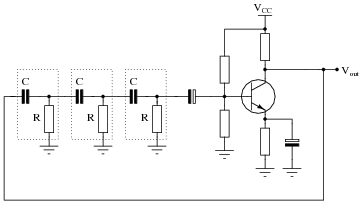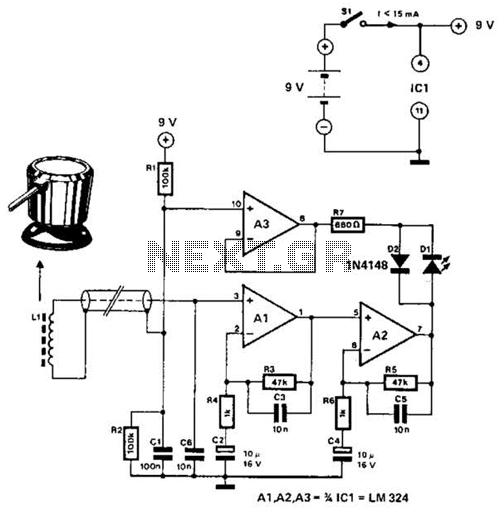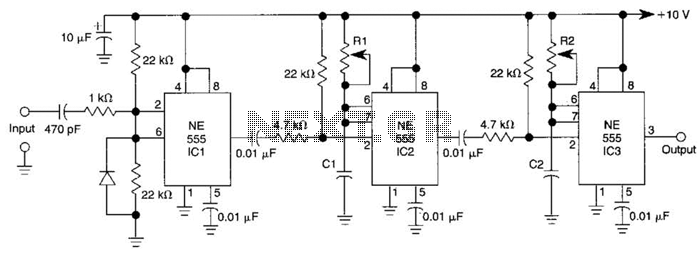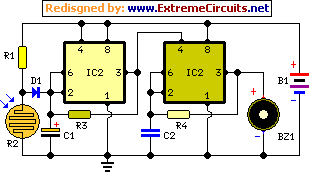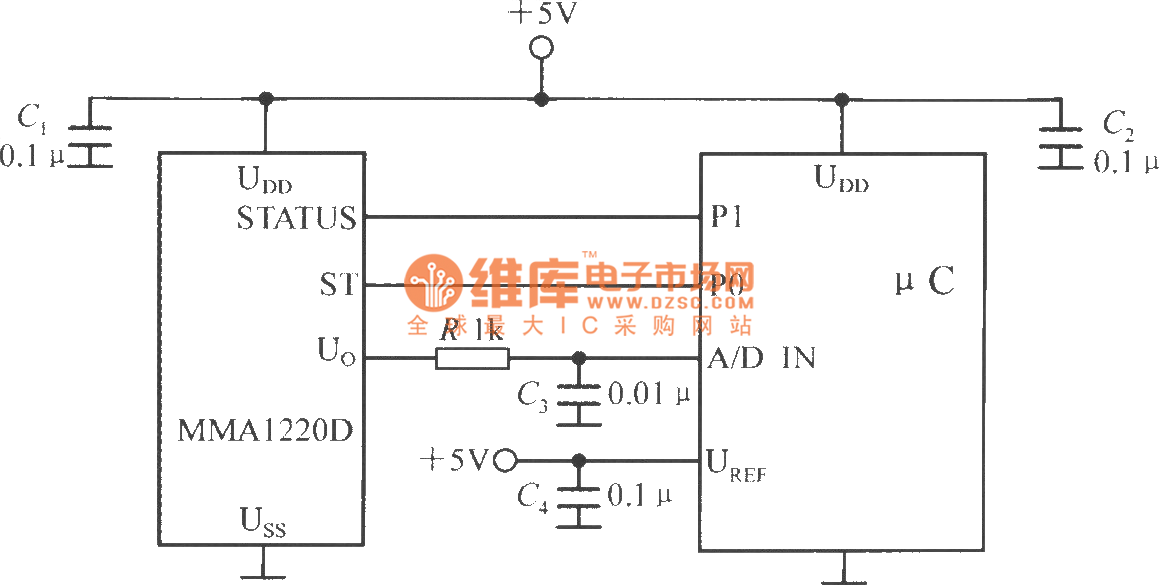
Infrared Alarm Barrier Circuit
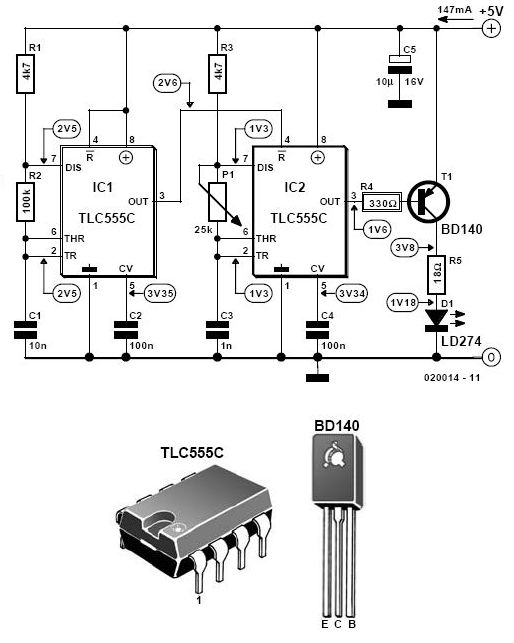
This infrared alarm barrier is designed to detect individuals passing through doorways, corridors, and small gates. The transmitter emits an invisible beam of infrared light. When this beam is interrupted by a person, a buzzer connected to the receiver is activated. The transmitter and receiver circuits of this infrared alarm system are engineered to operate over several meters, with minimal dependence on ambient light conditions. In rare cases where the receiver sensor is exposed to bright, direct sunlight, additional screening measures may be necessary. The transmitter does not emit a continuous infrared signal; instead, it utilizes a modulated signal, where the 36-kHz carrier frequency is pulsed on and off at approximately 300 Hz. This modulation is crucial because most infrared sensors, including those in the diagram, do not respond effectively to a continuous infrared light source. By briefly switching off the IR source, the detectors can recuperate, thus enhancing their ability to minimize responses to ambient light. The transmitter comprises two oscillators based on the widely used 555 integrated circuit (IC). The current-saving CMOS version, TLC555 (or 7555), is employed. Alternatively, two 555 ICs can be substituted with a single TLC556 (or 7556). IC1 serves as the 300-Hz generator, while IC2 generates the 36-kHz signal. The infrared emitting diode (IRED) type LD274 is pulsed at a high peak current through driver transistor T1. If the application requires a shorter range for the IR beam, resistor R5 can be increased to reduce current consumption. Preset P1 is calibrated to achieve an exact carrier frequency of 36 kHz (or adjusted for optimum range in the absence of testing equipment). The receiver circuit is similarly straightforward and also utilizes a CMOS 555. When the sensor detects infrared light from the transmitter, the reset input of the 555 IC remains low, keeping the buzzer silent. Components D1 and C2 function as a low-frequency rectifier to mitigate the effects of the 300-Hz modulation on the transmitted signal. When the infrared light beam is interrupted, the oscillator built around the 555 is activated, producing a warning tone. The test values indicated in the infrared barrier alarm circuit diagram represent average DC levels measured with a digital voltmeter (DVM) under varying light conditions. Most test points, however, exhibit rectangular or sawtooth waveforms.
The infrared alarm barrier system is characterized by its simplicity and effectiveness in providing security through motion detection. The design incorporates a transmitter and receiver pair that communicate via modulated infrared light, ensuring reliable operation even in varying environmental conditions. The use of the 555 timer ICs allows for precise control over the modulation frequencies, enhancing the system's sensitivity and response time.
The transmitter circuit begins with the TLC555 configured as an astable multivibrator, generating the 300 Hz pulse. This pulse drives the second 555 timer configured to produce a 36 kHz carrier frequency. The IRED is driven by a transistor, which amplifies the current to ensure that the infrared beam can cover the required distance. The modulation technique employed here is essential for optimizing the performance of the infrared sensors, as it allows them to better differentiate between the transmitted signal and ambient infrared noise.
In the receiver circuit, the incoming infrared signal is processed by another TLC555 timer configured to detect changes in the signal level. The low-frequency rectifier formed by D1 and C2 is crucial for filtering out the modulation frequency, allowing the receiver to respond only when the beam is interrupted. When a person passes through the beam, the interruption triggers the oscillator, which activates the buzzer, providing an audible alert.
Overall, this infrared alarm barrier system is an effective solution for security applications, offering a straightforward yet reliable method for detecting unauthorized access through monitored areas. Its design can be easily adapted to various settings, making it a versatile choice for both residential and commercial installations.This infrared alarm barrier can be used to detect persons passing through doorways, corridors and small gates. The transmitter emits a beam of infrared light which is invisible to the human eye. The buzzer at the output of the receiver is activated when the light beam is interrupted by a person passing through it.
The transmitter and receiver circ uits of the infrared alarm system shown here have been designed for a range of several meters, almost independent of ambient light conditions. Only in the rare case of the receiver sensor being exposed to bright, direct sunlight, some screening measures have to be added.
The transmitter does not emit a continuous infrared signal, Rather, it is modulated, that is, the 36-kHz carrier used to pulse the IRED (infrared emitting diode) on and off is itself switched on an off at a rate of about 300 Hz. The reason for doing so is that most infrared sensors, including the ones suggested in the diagram do not respond very well to continuous incidence of infrared light.
Switching the IR source off, even for a small period, allows IR detectors to recuperate`, and so optimise their ability to minimize the response to ambient light. The transmitter consists of two oscillators built around the ubiquitous 555 IC. Here, the current-saving CMOS version TLC555 (or 7555) is used. Alternatively, the two 555`s may be replaced by a single TLC556 (or 7556). IC1 is the 300-Hz generator, IC2, the 36-kHz source. The IRED type LD274 is pulsed at a relatively high peak current via driver transistor T1. If in your application the distance covered by the IR beam is relatively short, the value of resistor R5 may be increased to save on current consumption.
Preset P1 is adjusted for a carrier frequency of 36 kHz exactly (failing test equipment, adjust it for optimum range). The receiver is equally simple and also based on a CMOS 555. As long as the sensor picks up infrared light from the transmitter, the reset input of the 555 IC is held low and the buzzer is silent.
Components D1 and C2 act as a low-frequency rectifier to cancel the effect of the 300-Hz modulation on the transmitter signal. When the infrared light beam is interrupted, the oscillator built around the 555 is enabled and starts to produce a warning tone.
Finally, the test values indicated in the infrared barrier alarm circuit diagram are average dc levels measured with a DVM, under light/no light conditions. In fact, most test points carry rectangular or sawtooth waveforms. 🔗 External reference
The infrared alarm barrier system is characterized by its simplicity and effectiveness in providing security through motion detection. The design incorporates a transmitter and receiver pair that communicate via modulated infrared light, ensuring reliable operation even in varying environmental conditions. The use of the 555 timer ICs allows for precise control over the modulation frequencies, enhancing the system's sensitivity and response time.
The transmitter circuit begins with the TLC555 configured as an astable multivibrator, generating the 300 Hz pulse. This pulse drives the second 555 timer configured to produce a 36 kHz carrier frequency. The IRED is driven by a transistor, which amplifies the current to ensure that the infrared beam can cover the required distance. The modulation technique employed here is essential for optimizing the performance of the infrared sensors, as it allows them to better differentiate between the transmitted signal and ambient infrared noise.
In the receiver circuit, the incoming infrared signal is processed by another TLC555 timer configured to detect changes in the signal level. The low-frequency rectifier formed by D1 and C2 is crucial for filtering out the modulation frequency, allowing the receiver to respond only when the beam is interrupted. When a person passes through the beam, the interruption triggers the oscillator, which activates the buzzer, providing an audible alert.
Overall, this infrared alarm barrier system is an effective solution for security applications, offering a straightforward yet reliable method for detecting unauthorized access through monitored areas. Its design can be easily adapted to various settings, making it a versatile choice for both residential and commercial installations.This infrared alarm barrier can be used to detect persons passing through doorways, corridors and small gates. The transmitter emits a beam of infrared light which is invisible to the human eye. The buzzer at the output of the receiver is activated when the light beam is interrupted by a person passing through it.
The transmitter and receiver circ uits of the infrared alarm system shown here have been designed for a range of several meters, almost independent of ambient light conditions. Only in the rare case of the receiver sensor being exposed to bright, direct sunlight, some screening measures have to be added.
The transmitter does not emit a continuous infrared signal, Rather, it is modulated, that is, the 36-kHz carrier used to pulse the IRED (infrared emitting diode) on and off is itself switched on an off at a rate of about 300 Hz. The reason for doing so is that most infrared sensors, including the ones suggested in the diagram do not respond very well to continuous incidence of infrared light.
Switching the IR source off, even for a small period, allows IR detectors to recuperate`, and so optimise their ability to minimize the response to ambient light. The transmitter consists of two oscillators built around the ubiquitous 555 IC. Here, the current-saving CMOS version TLC555 (or 7555) is used. Alternatively, the two 555`s may be replaced by a single TLC556 (or 7556). IC1 is the 300-Hz generator, IC2, the 36-kHz source. The IRED type LD274 is pulsed at a relatively high peak current via driver transistor T1. If in your application the distance covered by the IR beam is relatively short, the value of resistor R5 may be increased to save on current consumption.
Preset P1 is adjusted for a carrier frequency of 36 kHz exactly (failing test equipment, adjust it for optimum range). The receiver is equally simple and also based on a CMOS 555. As long as the sensor picks up infrared light from the transmitter, the reset input of the 555 IC is held low and the buzzer is silent.
Components D1 and C2 act as a low-frequency rectifier to cancel the effect of the 300-Hz modulation on the transmitter signal. When the infrared light beam is interrupted, the oscillator built around the 555 is enabled and starts to produce a warning tone.
Finally, the test values indicated in the infrared barrier alarm circuit diagram are average dc levels measured with a DVM, under light/no light conditions. In fact, most test points carry rectangular or sawtooth waveforms. 🔗 External reference
